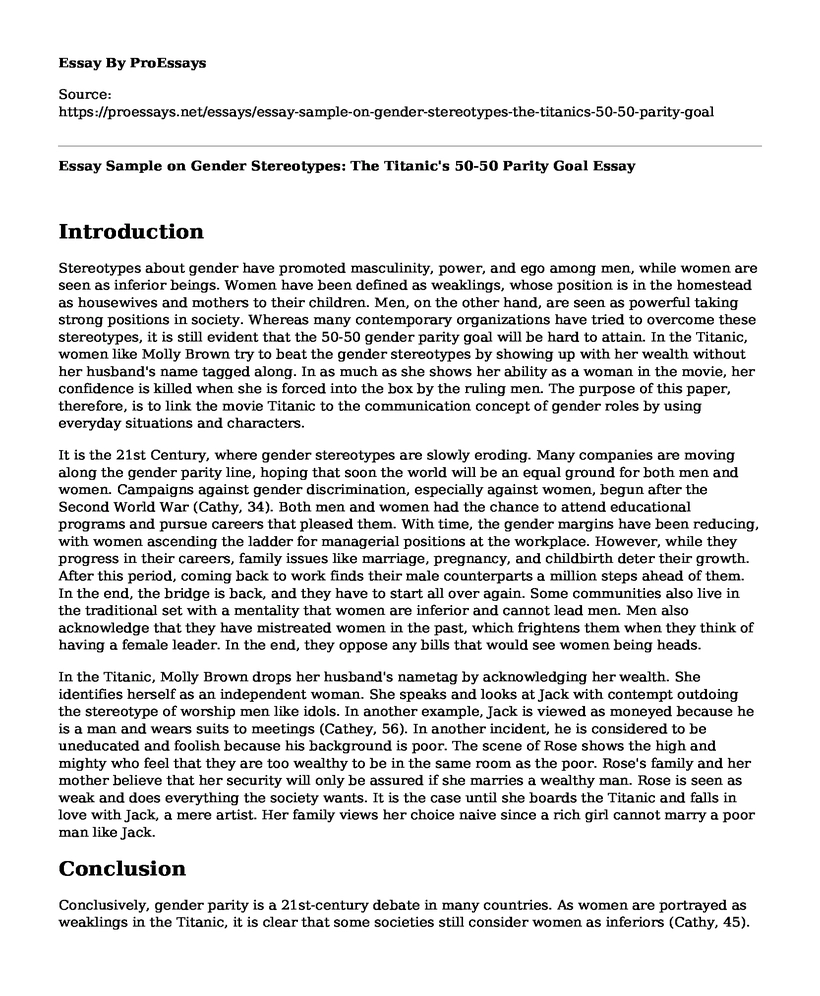Introduction
Stereotypes about gender have promoted masculinity, power, and ego among men, while women are seen as inferior beings. Women have been defined as weaklings, whose position is in the homestead as housewives and mothers to their children. Men, on the other hand, are seen as powerful taking strong positions in society. Whereas many contemporary organizations have tried to overcome these stereotypes, it is still evident that the 50-50 gender parity goal will be hard to attain. In the Titanic, women like Molly Brown try to beat the gender stereotypes by showing up with her wealth without her husband's name tagged along. In as much as she shows her ability as a woman in the movie, her confidence is killed when she is forced into the box by the ruling men. The purpose of this paper, therefore, is to link the movie Titanic to the communication concept of gender roles by using everyday situations and characters.
It is the 21st Century, where gender stereotypes are slowly eroding. Many companies are moving along the gender parity line, hoping that soon the world will be an equal ground for both men and women. Campaigns against gender discrimination, especially against women, begun after the Second World War (Cathy, 34). Both men and women had the chance to attend educational programs and pursue careers that pleased them. With time, the gender margins have been reducing, with women ascending the ladder for managerial positions at the workplace. However, while they progress in their careers, family issues like marriage, pregnancy, and childbirth deter their growth. After this period, coming back to work finds their male counterparts a million steps ahead of them. In the end, the bridge is back, and they have to start all over again. Some communities also live in the traditional set with a mentality that women are inferior and cannot lead men. Men also acknowledge that they have mistreated women in the past, which frightens them when they think of having a female leader. In the end, they oppose any bills that would see women being heads.
In the Titanic, Molly Brown drops her husband's nametag by acknowledging her wealth. She identifies herself as an independent woman. She speaks and looks at Jack with contempt outdoing the stereotype of worship men like idols. In another example, Jack is viewed as moneyed because he is a man and wears suits to meetings (Cathey, 56). In another incident, he is considered to be uneducated and foolish because his background is poor. The scene of Rose shows the high and mighty who feel that they are too wealthy to be in the same room as the poor. Rose's family and her mother believe that her security will only be assured if she marries a wealthy man. Rose is seen as weak and does everything the society wants. It is the case until she boards the Titanic and falls in love with Jack, a mere artist. Her family views her choice naive since a rich girl cannot marry a poor man like Jack.
Conclusion
Conclusively, gender parity is a 21st-century debate in many countries. As women are portrayed as weaklings in the Titanic, it is clear that some societies still consider women as inferiors (Cathy, 45). However, other organizations have recognized the potential of women by allowing them to grow their careers and lead. Therefore, both men and women stand equal chances to be respected and have their careers in their lives. Both men and women can make independent decisions without public or family manipulations.
Works Cited
Cathey, Judith E. "RMS Titanic: creating an American obsession." (2017). https://scholar.utc.edu/honors-theses/107/
Cite this page
Essay Sample on Gender Stereotypes: The Titanic's 50-50 Parity Goal. (2023, May 22). Retrieved from https://proessays.net/essays/essay-sample-on-gender-stereotypes-the-titanics-50-50-parity-goal
If you are the original author of this essay and no longer wish to have it published on the ProEssays website, please click below to request its removal:
- Case Study: Child Abuse
- Global Child Advocacy Issues: Trafficking of Children in Barbados Paper Example
- Multicultural Evaluation of Psychological Test Bias Paper Example
- Essay on Transformation of the World: Technology, Ideas, and Literary Theory
- Essay on Effective Communication: Overcoming Barriers & Utilizing Channels
- Essay on Perceptual Awareness & Attention: Examining the Relationship
- Essay Example on Who Owns a Child? Exploring the Debate on Paternity Fraud Laws







